VR Mainstream Wars: The Red Devil RX 6600 XT & the RTX 3060 Showdown in VR with a Valve Index
The RX 6600 XT is priced starting at $379 while the factory overclocked Red Devil is priced higher than the $399 RTX 3060 Ti Founders Edition, yet AMD has positioned its newest mainstream video card against the entry level $329 RTX 3060. We have found the Red Devil RX 6600 XT to be a bit faster than than the RTX 3060 in rasterized pancake games but outclassed by the Ti. For this VR showdown, we will use the Valve Index and 10 VR games to compare the performance of the RX 6600 XT with the RTX 3060.
We want to see if the RX 6600 XT is worthy of AMD’s claim of VR premium and how it compares with the RTX 3060 which is adequate as an entry level mainstream card to power a Valve Index. Although a fast CPU is important for geometry and other processing, smooth VR delivery depends mostly on the video card. An underpowered video card can even cause reprojecting and artifacting for a substandard playing experience that may even lead to VR sickness.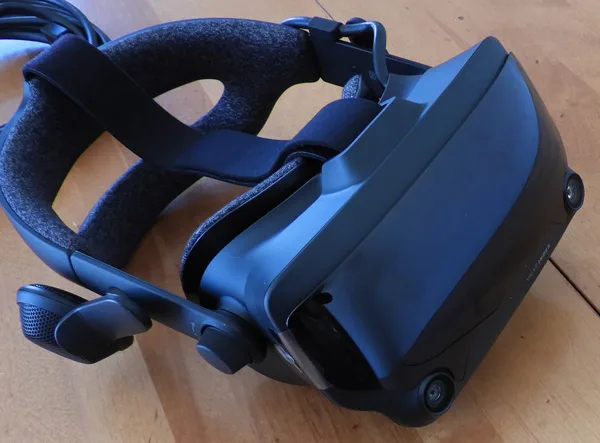 We currently benchmark ten VR games using the Valve Index that features 2880×1600 resolution (1440×1600 pixels per eye), the same as the Vive Pro and with similar performance at 90Hz/90FPS. BTR’s testing platform is an overclocked Intel Core i9-10900K, an EVGA Z490 FTW motherboard, and 32 GB of Vulcan Dark Z DDR4 at 3600MHz on a recent clean install of Windows 10 64-bit Pro Edition.
We currently benchmark ten VR games using the Valve Index that features 2880×1600 resolution (1440×1600 pixels per eye), the same as the Vive Pro and with similar performance at 90Hz/90FPS. BTR’s testing platform is an overclocked Intel Core i9-10900K, an EVGA Z490 FTW motherboard, and 32 GB of Vulcan Dark Z DDR4 at 3600MHz on a recent clean install of Windows 10 64-bit Pro Edition.
It is important to be aware of VR performance since poorly delivered frames can make a VR experience unpleasant. It’s also important to understand how we accurately benchmark VR games using FCAT-VR as explained here. But before we benchmark our VR games, check out our Test Configuration below.
Test Configuration – Hardware
- Intel Core i9-10900K (HyperThreading/Turbo boost On; All cores overclocked to 5.1GHz/5.0Ghz. Comet Lake DX11 CPU graphics)
- EVGA Z490 FTW motherboard (Intel Z490 chipset, v1.3 BIOS, PCIe 3.0/3.1/3.2 specification, CrossFire/SLI 8x+8x), supplied by EVGA
- T-FORCE DARK Z 32GB DDR4 (2x16GB, dual channel at 3600MHz), supplied by Team Group
- Valve Index, 90Hz
- EVGA RTX 3060 Black 12GB, stock clocks, on loan from EVGA
- Red Devil RX 6600 XT 8GB, stock clocks, on loan from PowerColor
- 2 x 1TB Team Group MP33 NVMe2 PCIe SSD for C: drive (one for AMD; one for NVIDIA)
- 1.92TB San Disk enterprise class SATA III SSD (storage)
- 2TB Micron 1100 SATA III SSD (storage)
- 1TB Team Group GX2 SATA III SSD (storage)
- 1TB T-FORCE DELTA MAX SATA III SSD (storage), supplied by Team Group
- ANTEC HCG1000 Extreme, 1000W gold power supply unit
- Samsung G7 Odyssey (LC27G75TQSNXZA) 27? 2560×1440/240Hz/1ms/G-SYNC/HDR600 monitor
- DEEPCOOL Castle 360EX AIO 360mm liquid CPU cooler
- Phanteks Eclipse P400 ATX mid-tower (plus 1 Noctua 140mm fan)
Test Configuration – Software
- GeForce 471.68 drivers – Stock settings in the NVIDIA control panel
- Adrenalin 21.8.1 drivers. Stock settings in the AMD control panel
- Windows 10 64-bit Pro edition; latest updates
- Latest DirectX
- All 10 VR games are patched to their latest versions at time of publication
- FCAT VR Capture (non-public) Beta
- FCAT VR Beta 18 (non-public)
- SteamVR – at 100% resolution
10 VR Game benchmark suite & 1 synthetic test
Synthetic
- OpenVR Benchmark
SteamVR Games
- Assetto Corsa Competizione
- Borderlands 2
- Boneworks
- Elite Dangerous
- Half Life: Alyx
- No Man’s Sky
- Pavlov
- Project CARS 2
- Skyrim
- The Walking Dead: Saints & Sinners
It is important to remember that BTR’s charts use frametimes in ms where lower is better, but we also compare “unconstrained framerates” which shows what a video card could deliver (headroom) if it wasn’t locked to either 90 FPS or to 45 FPS by the HMD. In the case of unconstrained FPS which measures just one important performance metric, faster is better.
Let’s individually look at our ten VR games’ performance using FCAT VR. All of our games were benchmarked at 100% SteamVR resolution as we benchmark the Red Devil RX 6600 XT to see how it compares with the EVGA RTX 3060 Black.
The OpenVR benchmark ranks the RX 6600 XT and the RTX 3060 almost identically.


But we really want to see gaming benchmarks. First up, Assetto Corsa Competizione.
Assetto Corsa Competizione
BTR’s sim/racing editor, Sean Kaldahl created the replay benchmark run used for both the pancake game and the VR game. It is run at night with lots of geometry, and the lighting effects of the headlights, tail lights, and everything around the track adds to the feel of racing.
Just like with Project CARS, you can save a replay after a race. The CPU usage is the same between a race and its replay so it is a reasonably accurate benchmark using the Circuit de Spa-Francorchamps against 20 AI drivers.
Although iRacing may be more accurate or realistic, Assetto Corsa Competizione has some appeal because it feels more real than many other racing sims. It delivers the sensation of handling a highly-tuned racing machine driven to its edge.
Here are the VR Low frametimes.
Here are the details are reported by FCAT-VR:
The RX 6600 XT managed to deliver 117.00 unconstrained FPS with no dropped frames or Warp misses, but 2 frames were synthesized.
The RTX 3060 achieved 126.33 unconstrained FPS with no dropped frames nor Warp misses but with 1 synthetic frame generated.
The RTX 3060 has a bit more performance headroom than its Radeon competitor.
VR Low shows a noticeable drop in visuals from VR High and we would suggest lowering individual settings instead of dropping from presets to stay out of reprojection if possible. Unfortunately, there is no “VR Medium” preset.
Next, we look at Borderlands 2 performance.
Borderlands 2
Borderlands 2 is a full version of the pancake version sans co-op. Battles deliver frantic in-your face 360 degree superfast action with endless weapon combination possibilities which are even more intense and addictive in VR, and if there is a way to enable the 120Hz option without reprojecting frames, we’d recommend using it over 90Hz.
We benchmark at 100% resolution with medium/near/normal in-game settings and plus 16xAF and FXAA as below.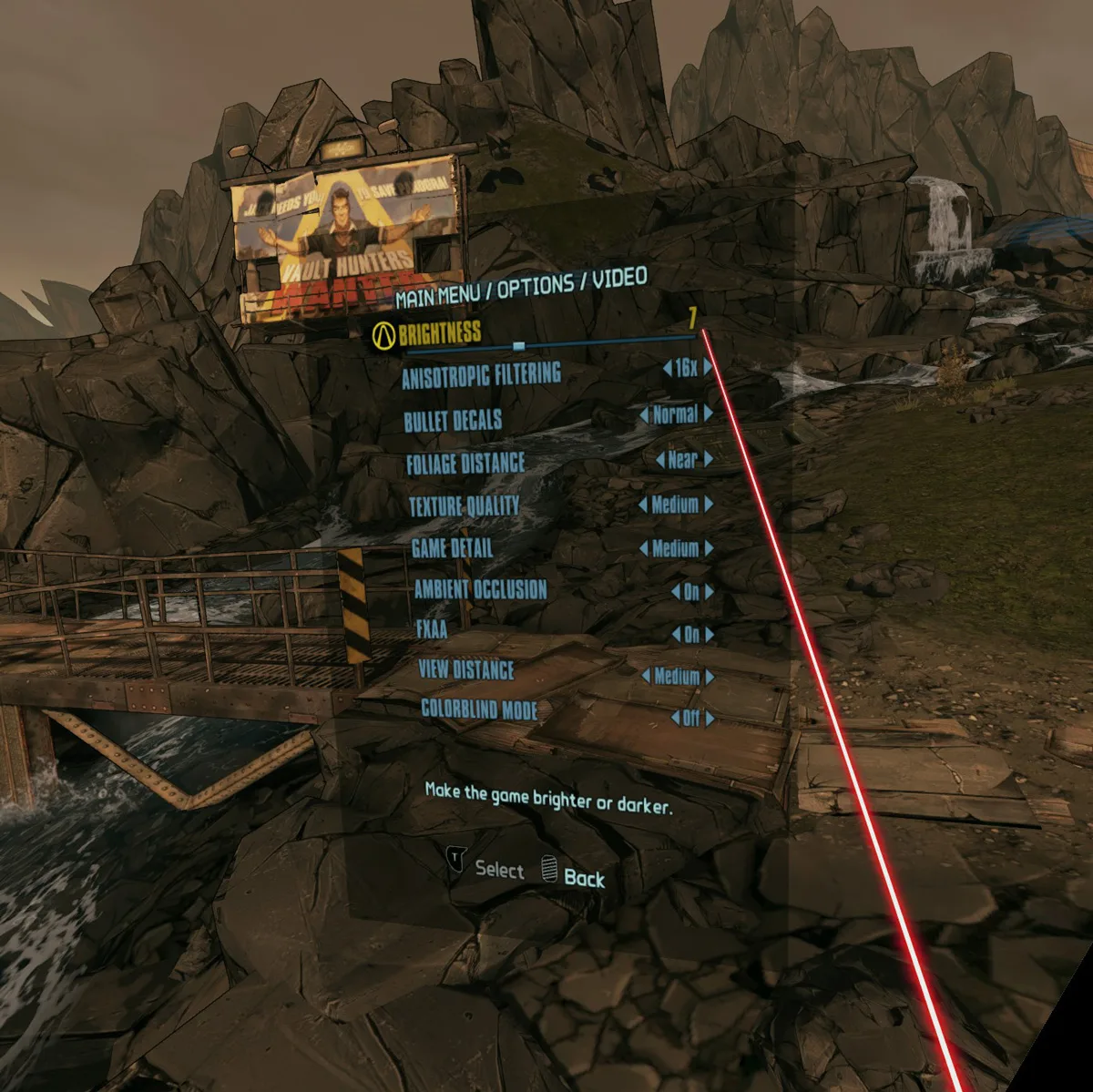
Here is the frametime plot for Borderlands 2.
The RX 6600 XT delivered 104.45 unconstrained FPS with no dropped frames, no Warp misses, nor any synthesized frames.
The RTX 3060 delivered 106.71 unconstrained FPS with no dropped frames and no Warp misses, but it required 35 synthetic frames.
Borderlands 2 looks great at 100% resolution with medium detail, and both cards give a comparably good VR experience.
Next, we look at Boneworks.
Boneworks
Boneworks is a rare game that couples a fair single player campaign with an incredible sandbox and next generation VR physics interactive tour de force. We benchmark using the ‘Time Tower’ level.
Boneworks made on the Unity engine has average to very good visuals and it particularly benefits by allowing for high levels of MSAA up to 8X which we use for benching. We also enable ambient occlusion and use the highest settings, and we leave SteamVR’s resolution at 100%.
Here are the frametimes plots of both of our cards.
Here are the details are reported by FCAT-VR:
The RX 6600 XT delivered 149.34 unconstrained FPS with no dropped frame or Warp misses and no frames were synthesized.
The RTX 3060 achieved 148.58 unconstrained FPS with no dropped frames and no synthetic frames or Warp misses.
There isn’t any difference playing with either cards at the highest settings at 100% resolution and it is possible to increase the SteamVR resolution. For GeForce cards, we recommend using VRSS for additional visual improvement with only a minor performance penalty.
Let’s check out Elite Dangerous next.
Elite Dangerous
Elite Dangerous is a popular space sim built using the COBRA engine. It is hard to find a repeatable benchmark outside of the training missions.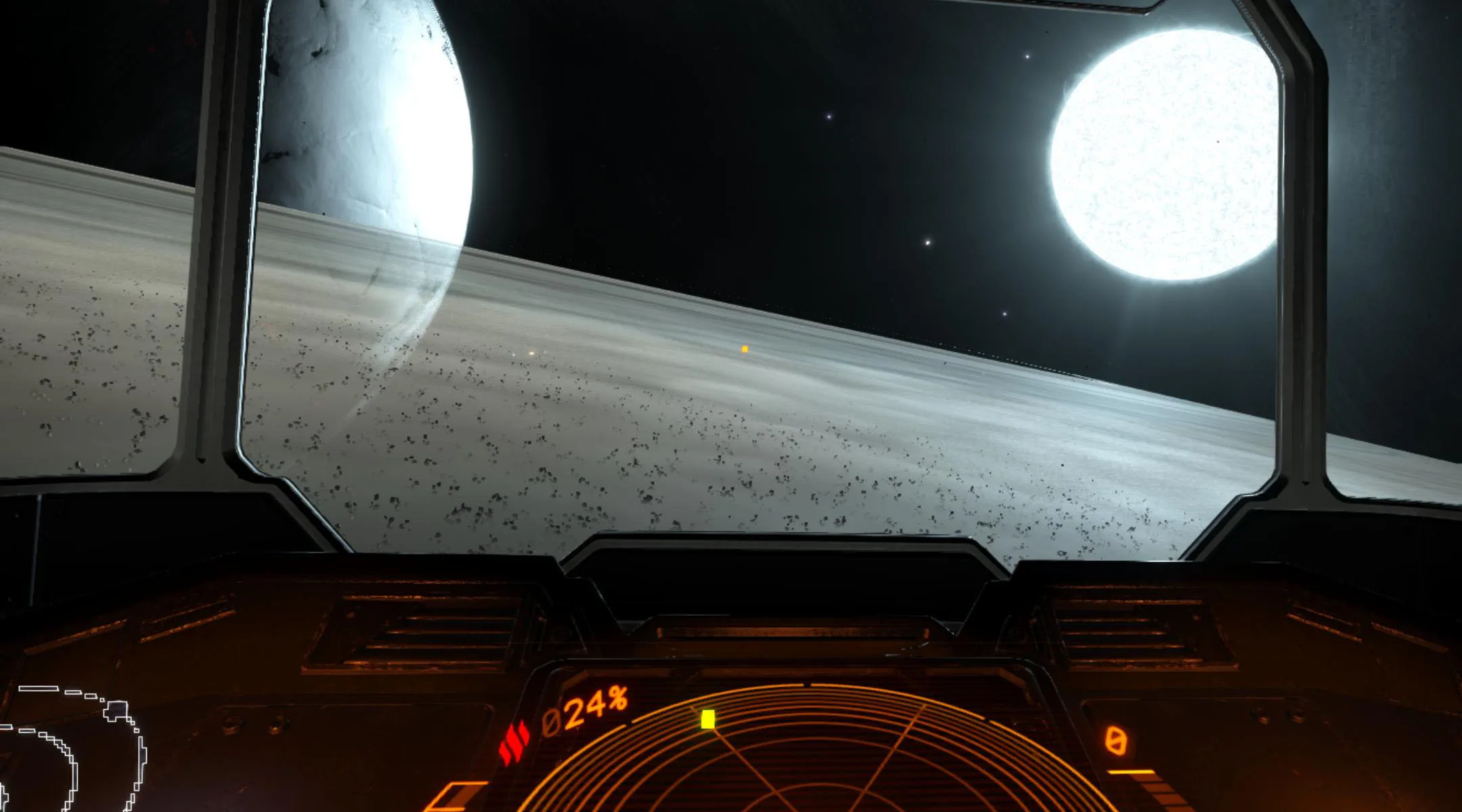
A player will probably spend a lot of time piloting his space cruiser while completing a multitude of tasks as well as visiting space stations and orbiting a multitude of different planets (~400 billion). Elite Dangerous is also co-op and multiplayer with a very dedicated following of players.
We picked the Medium Preset and we set the field of view (FoV) to its maximum. Here are the frametimes.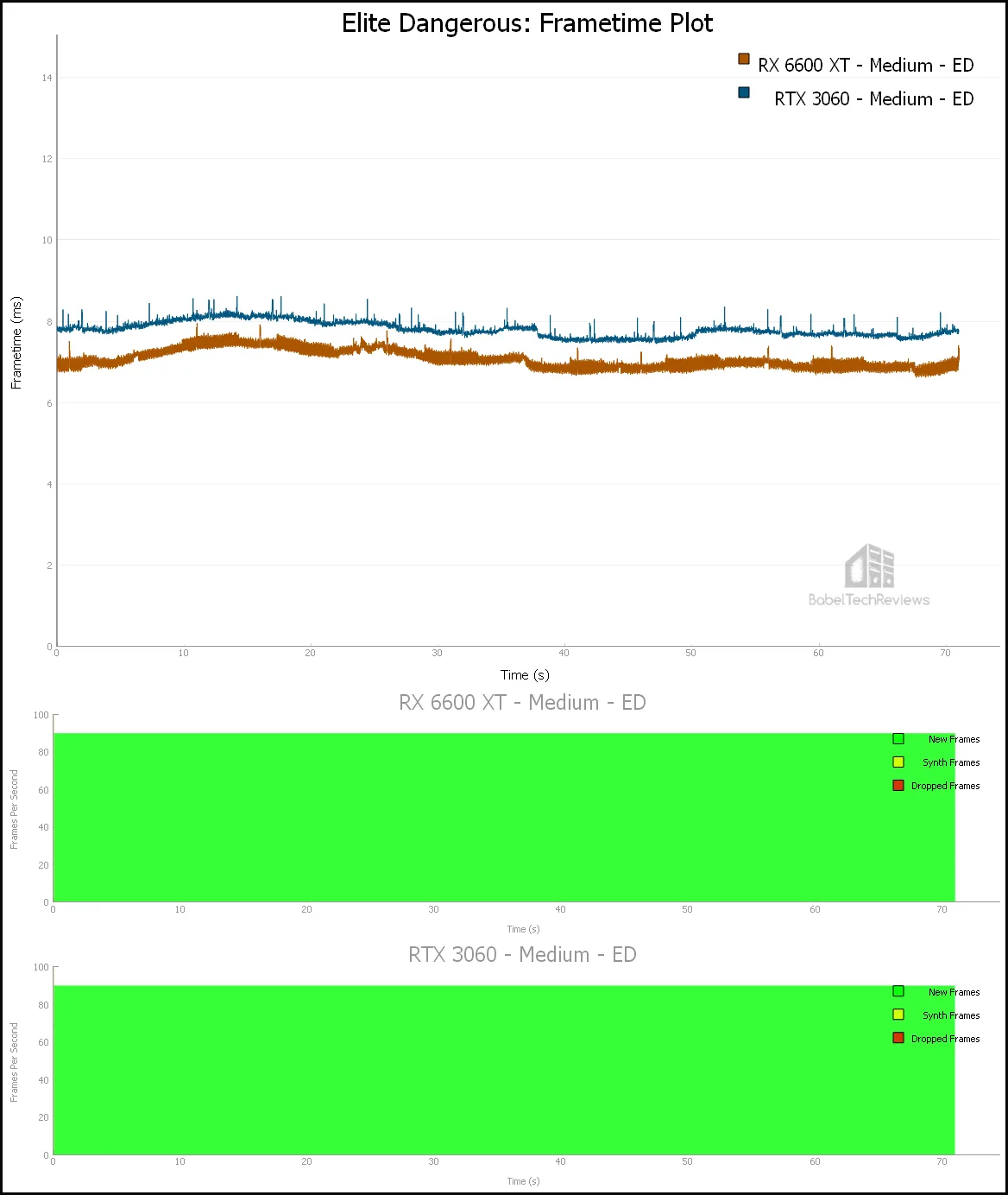
Here are the details are reported by FCAT-VR:
The RX 6600 XT delivered 141.51 unconstrained FPS with no dropped frames, no Warp misses, and none of its frames were synthesized.
The RTX 3060 delivered 128.22 unconstrained FPS with no dropped or synthesized frames nor any Warp misses.
Both cards deliver an identical experience on Medium settings, but the RX 6600 XT has a little extra performance headroom.
Let’s continue with Half Life: Alyx.
Half Life: Alyx
Half Life: Alyx uses an adaptive/dynamic scaling algorithm which uses a card’s performance headroom to subsample in demanding scenes and to supersample in less demanding scenes. We used its console commands to lock the SteamVR resolution to 100% so that it did not supersample or subsample and we set the graphics preset to High.
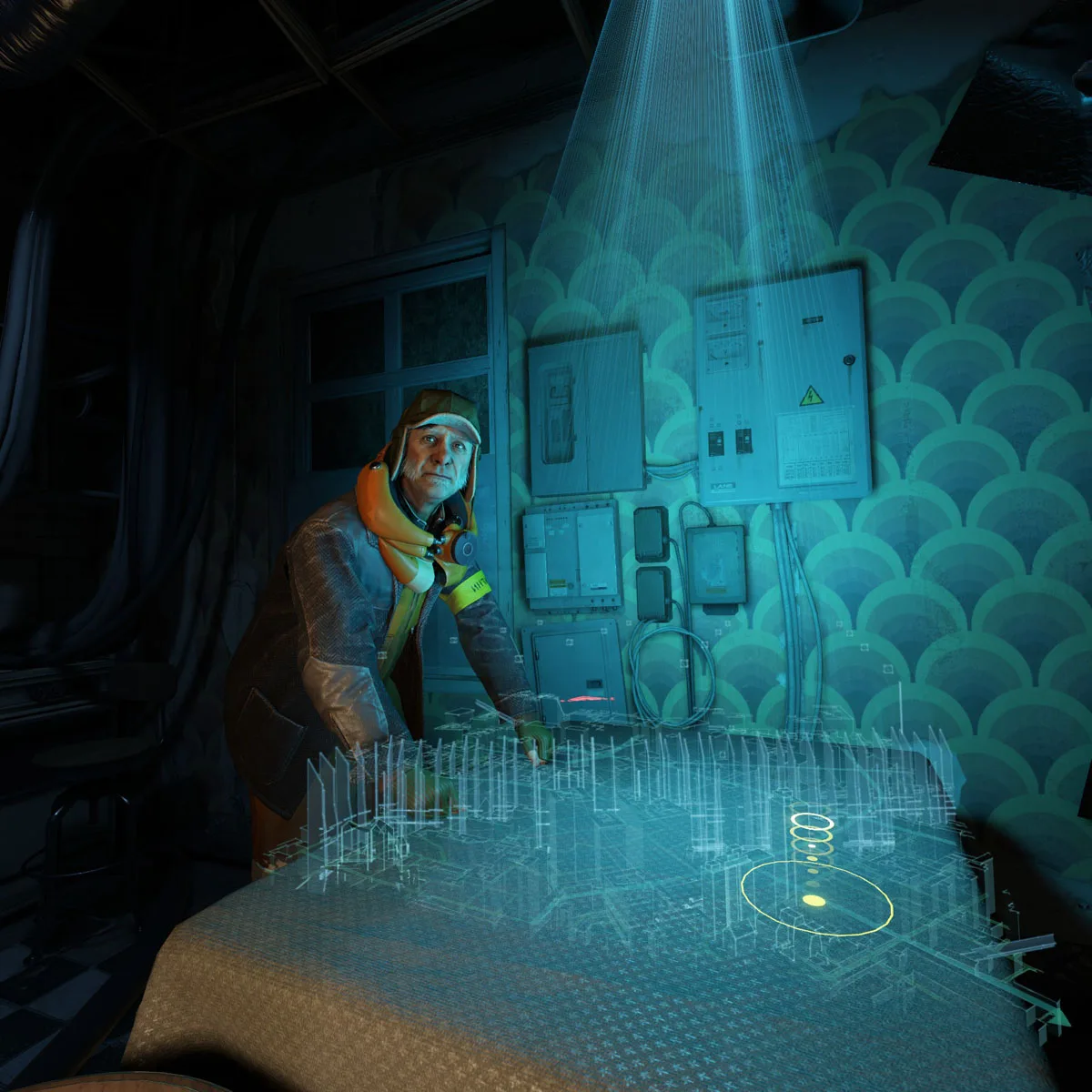 Here is the frametime plot for Half Life Alyx.
Here is the frametime plot for Half Life Alyx.
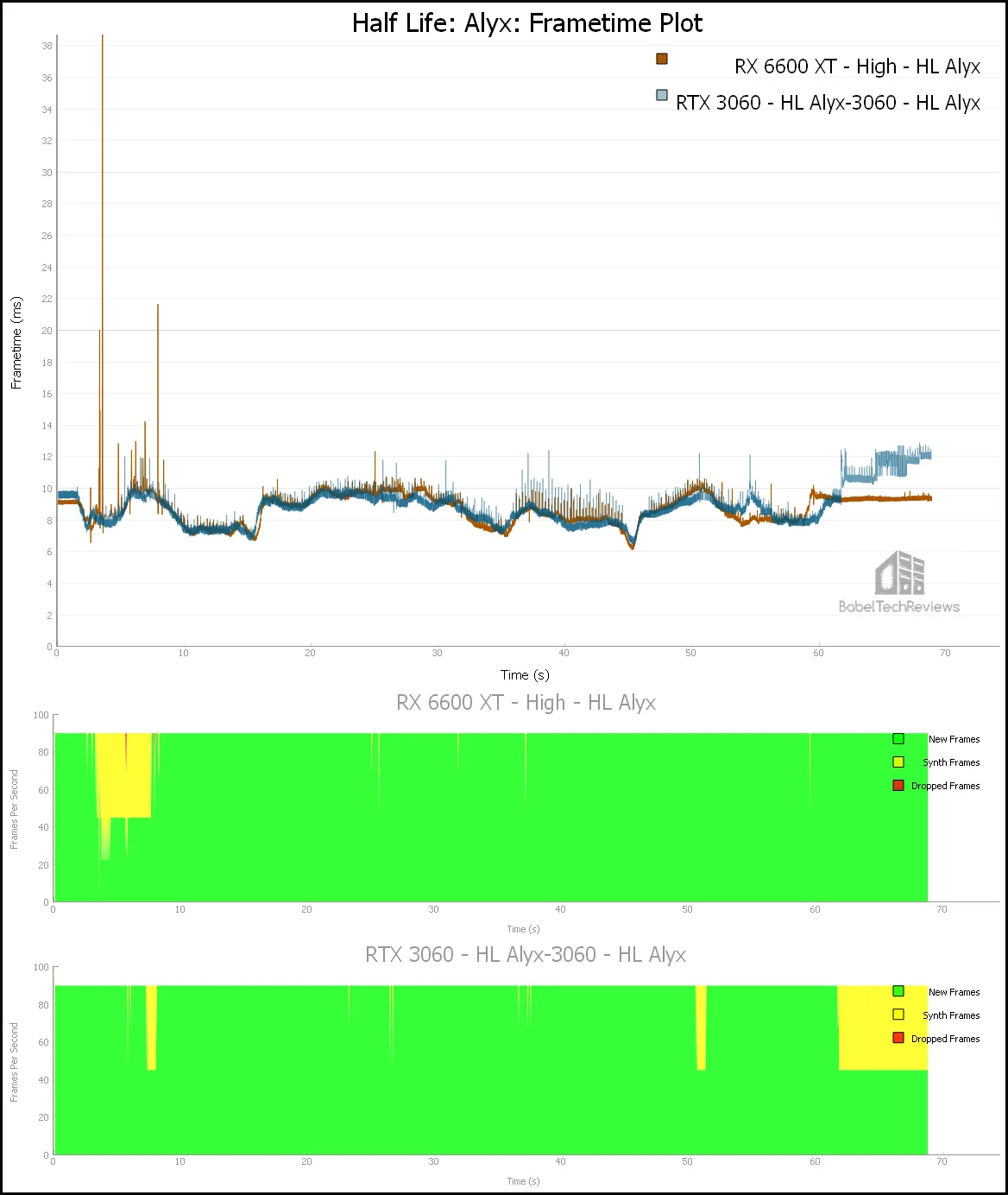
Here are the details as reported by FCAT-VR.
The RX 6600 XT delivered 114.87 unconstrained FPS with 2 dropped frames and 2 Warp misses, but 222 (4%) of its frames were synthesized.
The RTX 3060 managed 114.43 unconstrained FPS with no Warp misses but with 2 dropped frames and 399 (6%) synthetic frames.
Half Life: Alyx isn’t particularly demanding unless the Super Resolution increased in SteamVR settings, but unless console commands are used, the game will automatically subsample or supersample as needed and it will run fine with High settings on both cards. Unfortunately, while playing the game, Warp misses happened too frequently with the 6600 XT to mar an otherwise good VR experience.
Next, we will check out another demanding VR game, No Man’s Sky.
No Man’s Sky
No Man’s Sky is an action-adventure survival single and multiplayer game that emphasizes survival, exploration, fighting, and trading. It is set in a procedurally generated deterministic open universe, which includes over 18 quintillion unique planets using its own custom game engine.
The player takes the role of a Traveller in an uncharted universe by starting on a random planet with a damaged spacecraft equipped with only a jetpack-equipped exosuit and a versatile multi-tool that can also be used for defense. The player is encouraged to find resources to repair his spacecraft allowing for intra- and inter-planetary travel, and to interact with other players.
Here is the No Man’s Sky Frametime plot. We set the settings to Standard, but we also set the anisotropic filtering to 16X and upgraded to FXAA+TAA. Although DLSS is available for RTX cards and the Quality setting improves performance without impacting image quality significantly, we did not test with it.
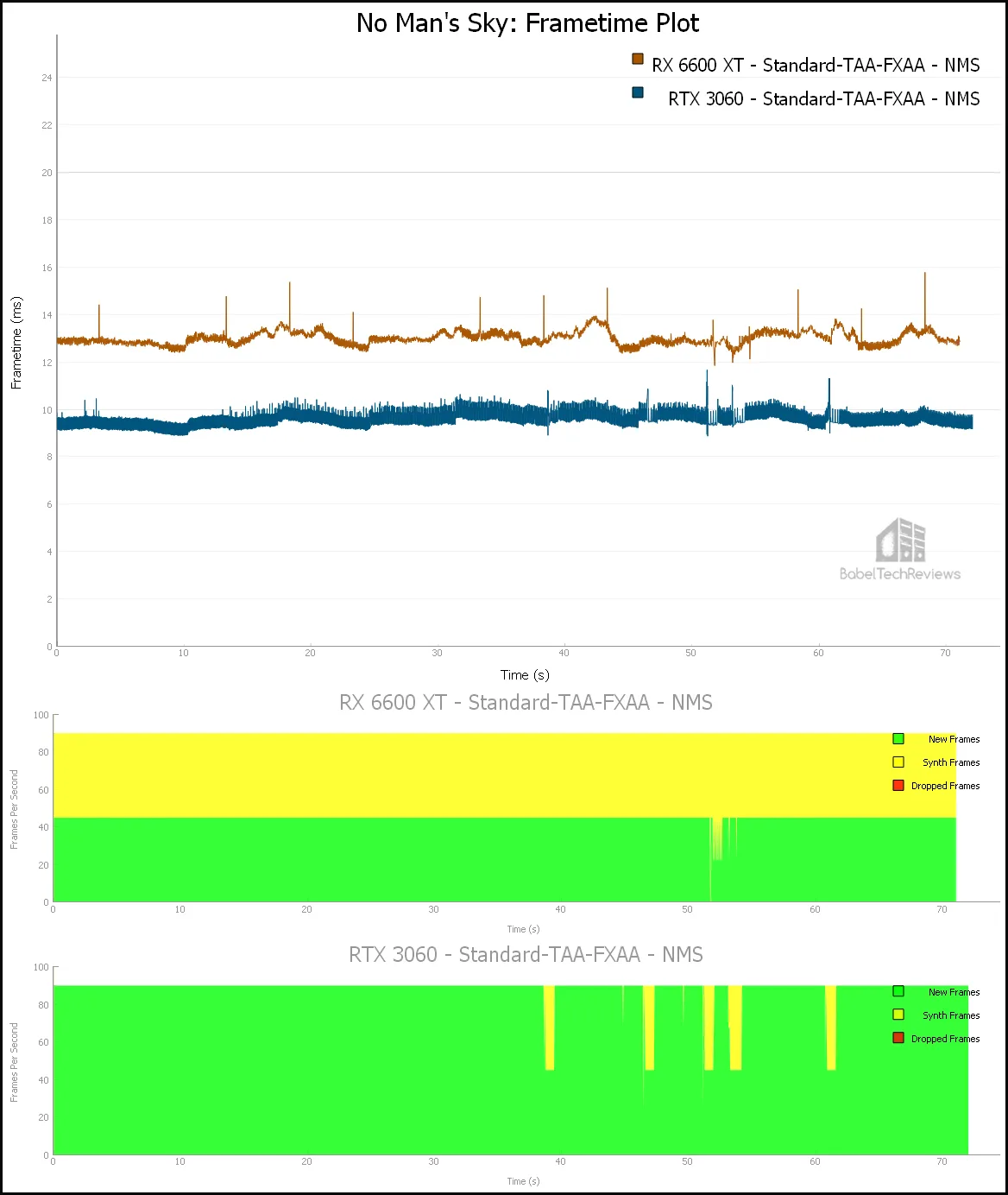 Here are the FCAT-VR details of our comparative runs.
Here are the FCAT-VR details of our comparative runs.
The RX 6600 XT delivered 76.91 unconstrained FPS with no dropped frames nor Warp misses, but 3221 (50%) frames were synthesized.
The RTX 3060 produced 103.61 unconstrained FPS with no dropped frames nor Warp misses, and it only required 191 (3%) synthetic frames.
Although, the RTX 3060 gives a better experience over the RX 6600 XT in No Man’s Sky using the Standard preset, it isn’t strong enough to play on the Enhanced setting without synthesizing frames.
Next we check out Pavlov.
Pavlov
There is a real sense of immersion that comes from playing Pavlov in VR. Pavlov is the most popular multiplayer VR shooter with a primary focus on its community. Realistic fast-paced combat is a large part of its core experience, and even tanks have been added.

We benchmarked using the training sessions with the highest settings.
The RX 6600 XT delivered 165.97 unconstrained FPS with no dropped, synthesized frames, or Warp misses.
The RTX 3060 delivered 175.96 unconstrained FPS also with no dropped, synthesized frames, or Warp misses.
The RTX 3060 delivers an identical VR experience to the RX 6600 XT although it has a little more performance headroom. We recommend that it be used for increasing the SteamVR render resolution or for playing at 120Hz.
Next we will check out another demanding VR game, Project CARS 2
Project CARS 2
There is a real sense of immersion that comes from playing Project CARS 2 in VR using a wheel and pedals. It uses its in-house Madness engine, and the physics implementation is outstanding. We are disappointed with Project CARS 3, and will continue to use the older game instead for VR benching.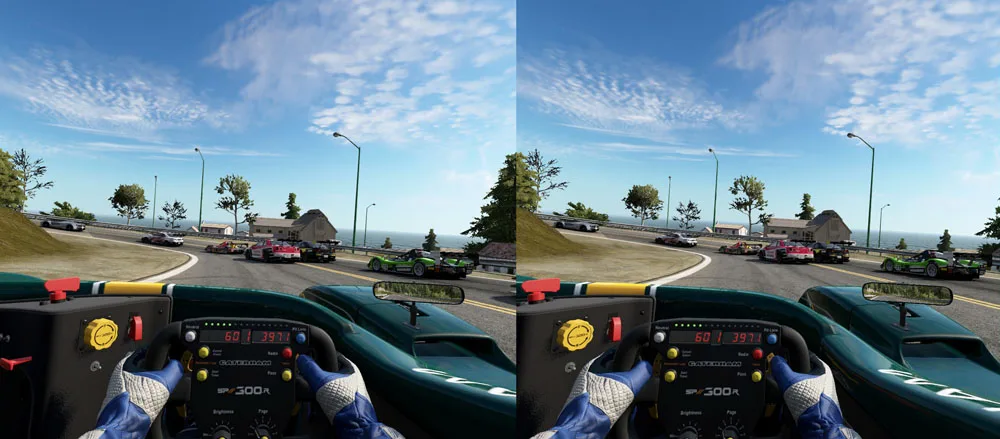
Project CARS 2 offers many performance options and settings and we prefer playing with SMAA Ultra.
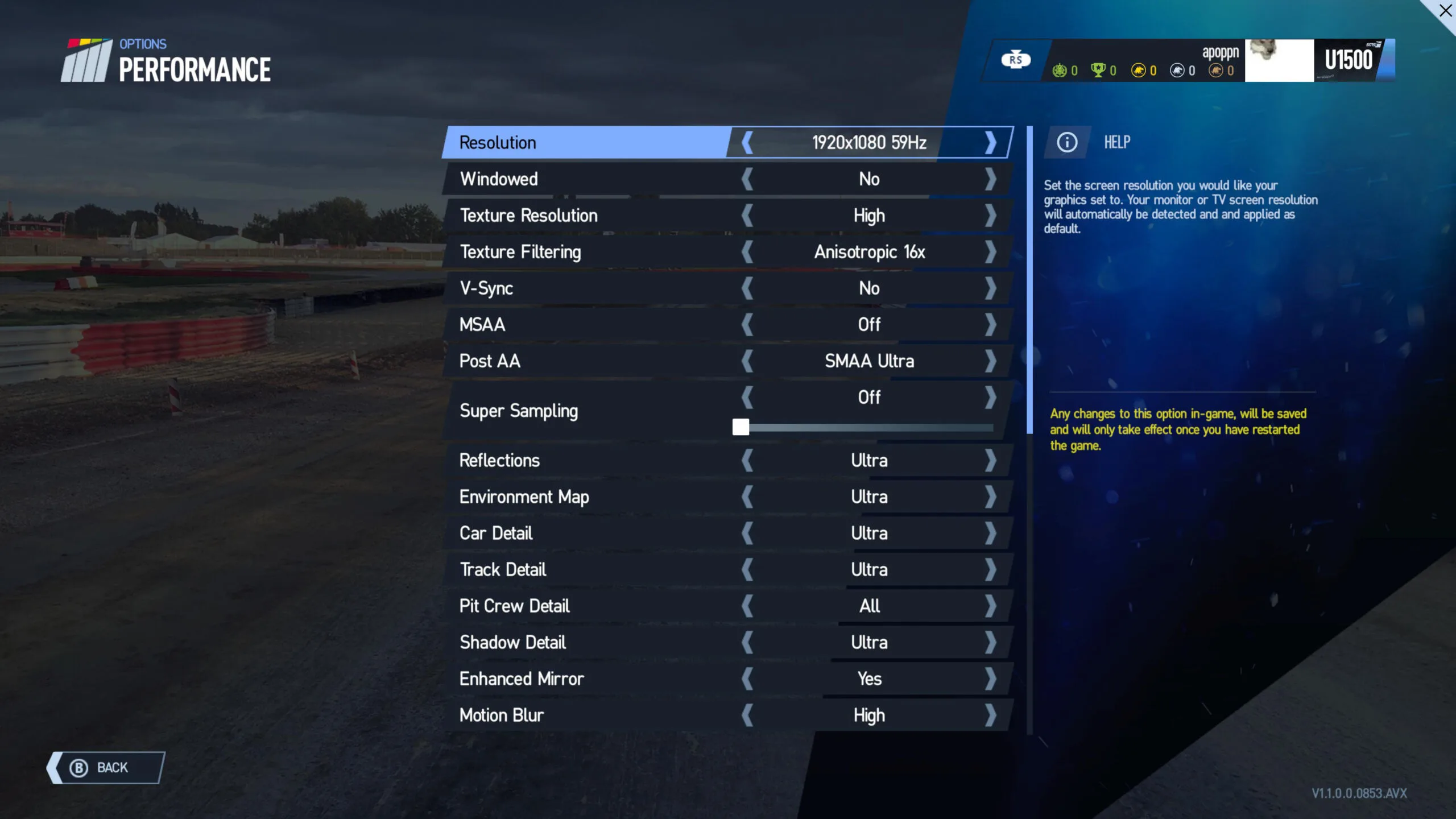
We used maximum settings including for Motion Blur although it looks best to us on Low or Medium. For lesser cards, we would also recommend lowering grass and reflections to maximize framerate delivery as motion smoothing or reprojection tends to cause visible artifacting.
The RX 6600 XT managed 100.15 unconstrained FPS with 17 dropped frame and 17 Warp misses but 566 (6%) frames were synthesized.
The RTX 3060 achieved 77.43 unconstrained FPS with 1 dropped frame and with 1 Warp miss but with 4820 (50%) synthetic frames. It had no Warp misses.
The experience playing Project CARS 2 on our medium VR settings is unsatisfactory for both cards and we would recommend lowering individual settings or even lower the resolution a bit as needed to stay out of reprojection. The RX 6600 XT is faster, but the VR experience is spoiled by dropped frames and Warp misses.
Let’s benchmark Skyrim VR.
Skyrim VR
Skyrim VR is an older game that is no longer supported by Bethesda, but fortunately the modding community has adopted it. It is not as demanding as many of the newer VR ports so its performance is still very good on maxed-out settings using its Creation engine.
We benchmarked Skyrim VR using its highest settings but we did not increase or Supersample the resolution.
Here are the frametime results.
Here are the details of our comparative runs as reported by FCAT-VR.
The RX 6600 XT delivered 128.30 unconstrained FPS with no dropped or synthetic frames and there were no Warp misses.
The RTX 3060 managed 129.39 unconstrained FPS, also with no dropped frames or Warp misses, but 26 synthetic frames were produced
Both cards deliver an identical experience with a little bit of performance headroom to add mods or to Supersample.
Last up, The Walking Dead: Saints & Sinners.
The Walking Dead: Saints & Sinners
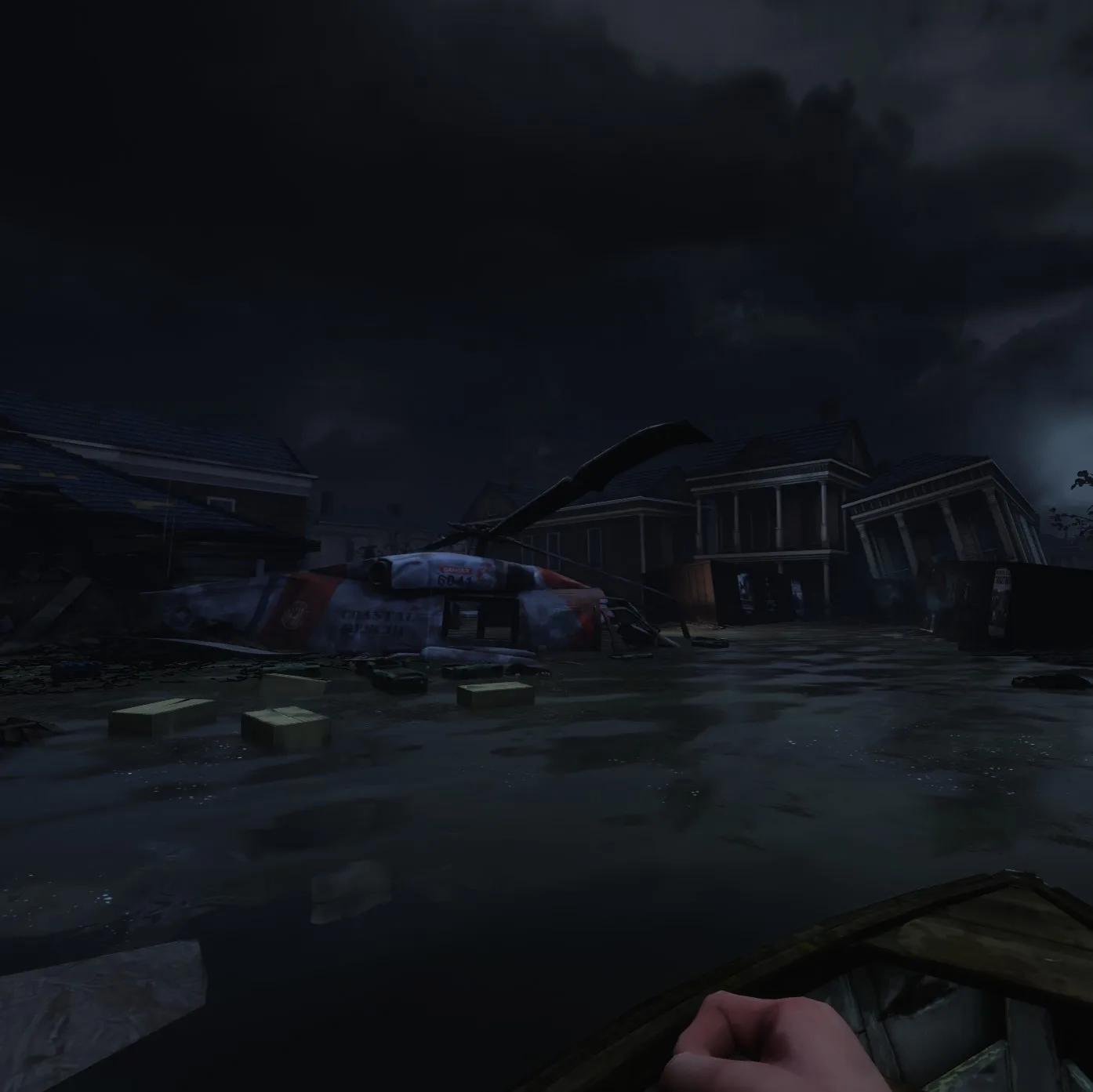 The Walking Dead: Saints & Sinner is the last of BTR’s 10 VR game benching suite. It is a first person survival horror adventure RPG with a strong emphasis on crafting. Its visuals using the Unreal 4 engine are outstanding and it makes good use of physics for interactions.
The Walking Dead: Saints & Sinner is the last of BTR’s 10 VR game benching suite. It is a first person survival horror adventure RPG with a strong emphasis on crafting. Its visuals using the Unreal 4 engine are outstanding and it makes good use of physics for interactions.
We benchmarked Saints and Sinners using its highest settings and we left the Pixel Density at 100%.. 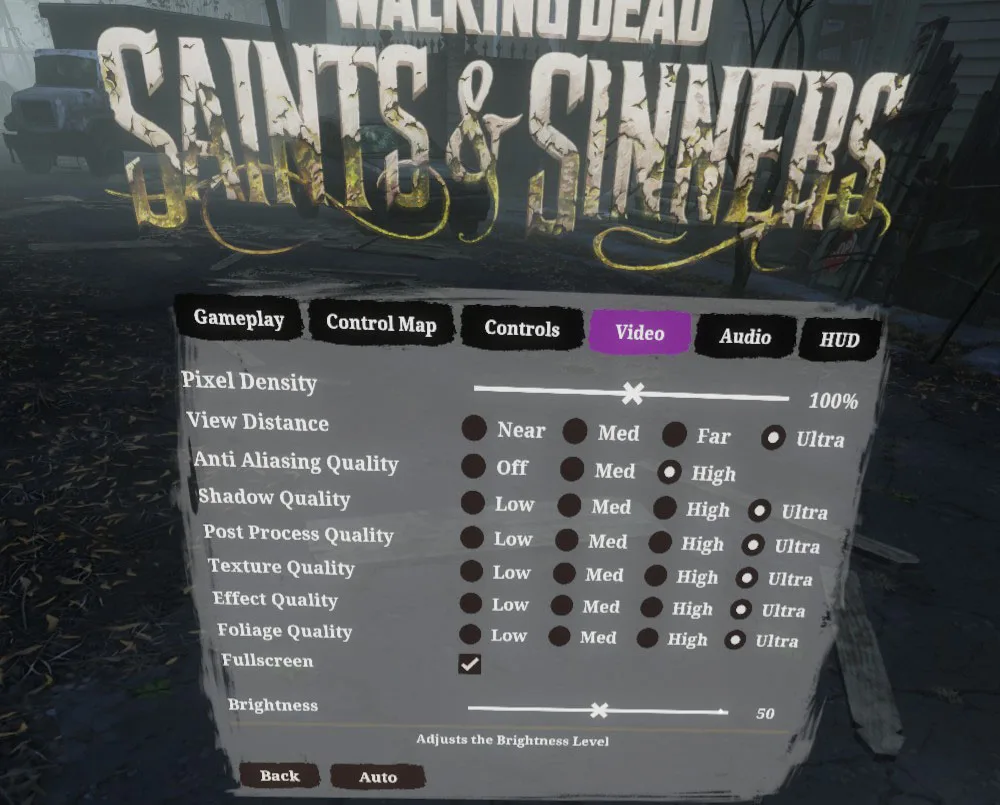 Here is the frametime chart. Please note that the Pixel Density is 100%.
Here is the frametime chart. Please note that the Pixel Density is 100%.
Here are the details as reported by FCAT-VR. 
The RX 6600 XT produced 120.55 unconstrained FPS with 7 dropped frames and 7 Warp misses, but 114 (2%) frames were synthesized.
The RTX 3060 managed 115.00 unconstrained FPS with no dropped frames nor Warp misses and 37 (1%) synthetic frames were generated.
Playing The Walking Dead: Saints & Sinners using the in-game maximum settings and 100% Pixel Density should be similar for both of our cards although the RX 6600 XT has too many dropped frames and Warp misses.
Let’s check out our conclusion.
Conclusion
It is great to see AMD and NVIDIA delivering two mainstream cards that are both priced below $400 – if they can be found at all at MSRP – that drop the entry price for VR. The EVGA RTX 3060 Black sits in a unique position as the fastest $329 MSRP video card available for VR and it offers reasonable performance for use with a Valve Index, and no doubt it would offer excellent performance for an original Vive, Rift CV1, or even for a Rift S. The Red Devil RX 6600 XT at above $400 should be slightly faster, but unfortunately it suffers from microstuttering together with excessive dropped frames and Warp misses, and we suggest that AMD’s driver team should address this.
Both the RTX 3060 and the RX 6600 XT can max multiple VR games in our benching suite if the resolution is left at 100% or slightly subsampled, or if the in-game settings are lowered. But if someone is going to spend $1000 for a premium HMD, it makes sense to pair it with a faster video card like the RTX 3060 Ti Founders Edition which is MSRP/SEP priced below the Red Devil RX 6600 XT. However, one cannot pair a high resolution headset like the Reverb G2 or the Vive Pro 2 with either card.
The RTX 3060 is a good card for high/medium quality PC VR at a rather bargain price of $329 – if it can be purchased at this price – and the RTX 3060 Ti is a more solid offering for $70 more. Unfortunately, the RX 6600 XT at $379 barely matches the experience of the RX 3060 at $329 – never mind the Red Devil at above $400 – and it needs some attention from AMD’s driver team before we can give it a solid recommendation for VR. We did not test DLSS in VR nor did we use FSR and will leave that comparison for a future review.
Next up, we plan to review Myst which launches tomorrow on Steam also in VR. It features ray tracing in the pancake version and DLSS in both versions.
Stay tuned to BTR!
Happy VR Gaming!


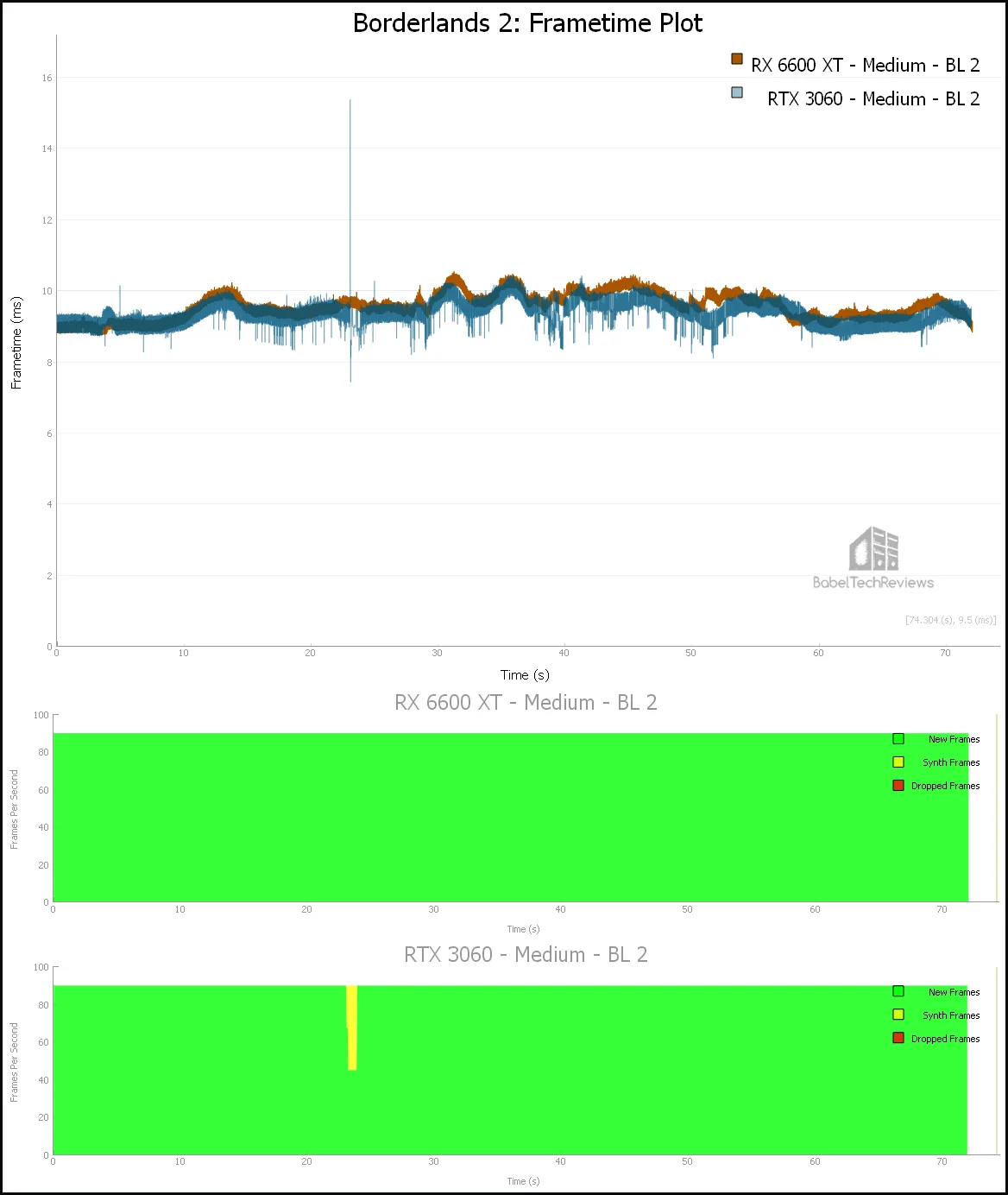



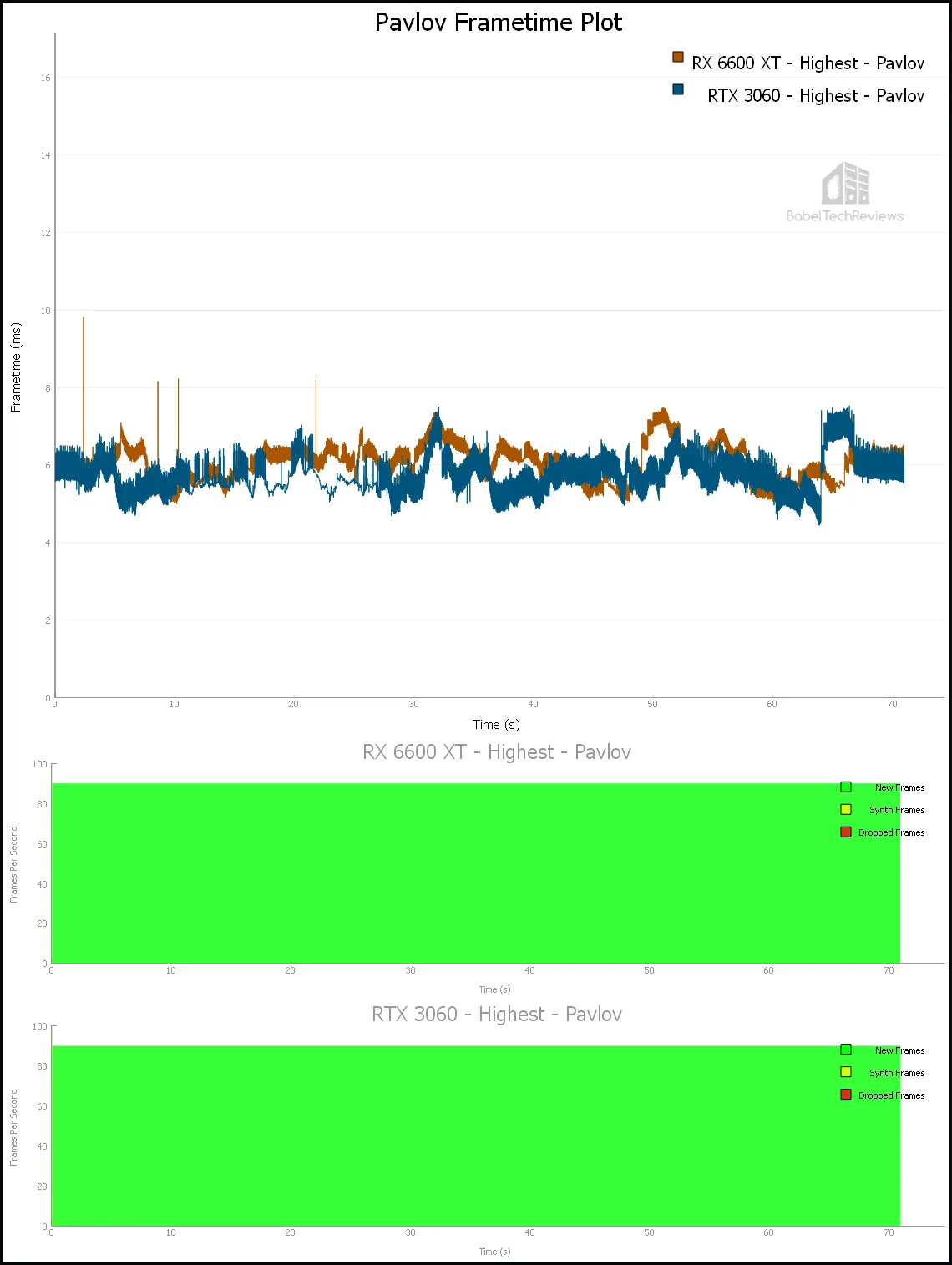




Comments are closed.